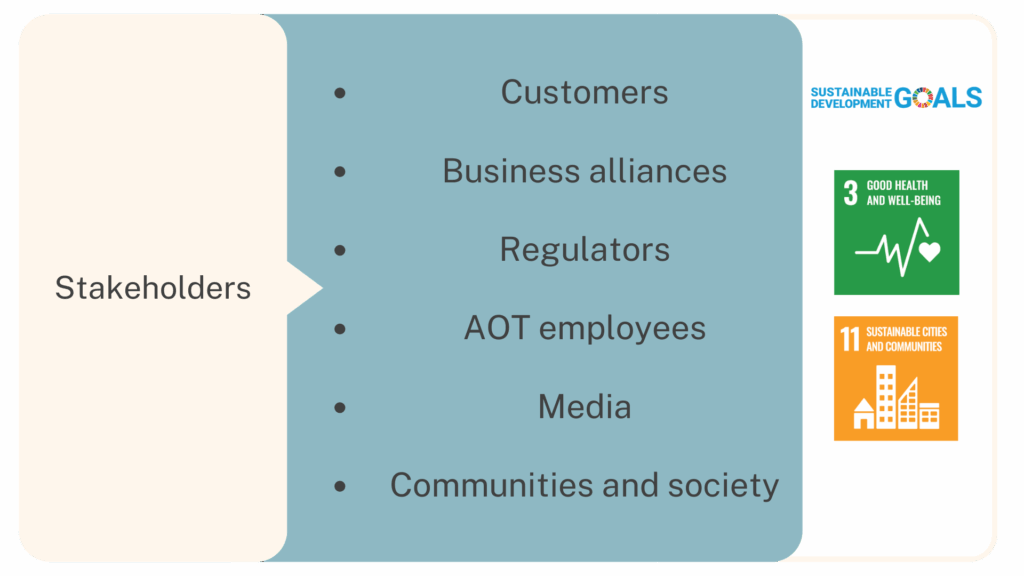
Importance
Safety and security at airports are crucial concerns that AOT diligently addresses in compliance with national laws, regulations, and requirements. Additionally, AOT aligns its practices with both domestic and international standards, including those set by the Civil Aviation Authority of Thailand (CAAT) and the International Civil Aviation Organization (ICAO). This commitment extends beyond airport operations to encompass surrounding communities and society, ensuring not only safe airport services but also security against unlawful activities and potential threats. By doing so, AOT safeguards fundamental human rights related to life and safety.
Robust safety measures foster confidence among customers, employees, and business partners, leading to increased trust and reliance on AOT’s air transport services. However, implementing stringent safety measures requires the integration of advanced technologies and continuous employee development to ensure full compliance with safety standards. Furthermore, AOT must continuously adapt its management systems to effectively uphold and enhance these rigorous safety measures.
Policy
AOT is committed to enhancing service quality, strengthening security, and minimizing airport security deficiencies through continuous audits and assessments. These evaluations are conducted both internally by supervisory officers and externally by the International Civil Aviation Organization (ICAO) under the Universal Security Audit Programme – Continuous Monitoring Approach (USAP-CMA).
Recognizing the critical importance of safety, AOT operates in alignment with its Safety Policy, which encompasses proactive measures and various initiatives to ensure that airport security measures comply with international standards. This commitment extends to adherence to relevant national and international laws, as well as industry best practices and recommendations.
| National Level | International Level |
|---|---|
|
|
AOT Safety Policy
AOT has established a safety policy to continuously develop and enhance safety standards, ensuring aviation operations achieve optimal safety performance in alignment with organizational strategies and corporate values. This policy also ensures compliance with the standards of the International Civil Aviation Organization (ICAO) while continuously improving the service quality management system.
The Airport Safety Policy consists of 11 key principles, covering the following critical aspects:
- To operate its airports with the highest safety standards based on regulations, compliance orientation, ICAO’s standards, and recommended practices under the strategies of AOT.
- To allocate adequate human resources, materials, equipment, and budgets for the efficiency of the safety management system (SMS).
- To support and build a sustainable “Just Culture” and “Positive Safety Culture” within AOT.
- To support the Mandatory and Voluntary Safety Reporting Systems as part of the SMS, as well as analyzing the root causes of such incidents without punishment unless the actions are advertently omitted, seriously reckless, or negligent when knowing that damages may occur.
- To encourage the use of the data-collection process and data analysis for data management under changing environments, as well as being tools for connecting with related sectors and exchanging safety data from them to drive the organization with data-driven decision-making, which will enhance the development of SMS efficiently.
- To provide measures, procedures, or mechanisms for protecting safety information as well as other related sources as part of SMS.
- To provide systems for checking and measuring the safety performance of the airports on a continuous basis by allowing each airport to set up its own safety performance indicators (SPI), targets, and alert level.
- To promote and develop personnel to possess skills, knowledge, and appropriate expertise for the effective implementation of safety, airport operations, and safety management.
- To encourage personnel to use digital technology in the operation of airport safety, which is consistent with the change of the organization that brings digital technology and innovation to drive the organization according to AOT strategies.
- To control, supervise, and take full responsibility for safety management according to SMS. Every executive at all levels, including employees and outsourced personnel, are urged to cooperate in safety until it becomes an organizational safety culture.
- To promote and support collaboration and integration of other safety systems such as occupational health and safety systems, security systems, and safety management systems of external related agencies.
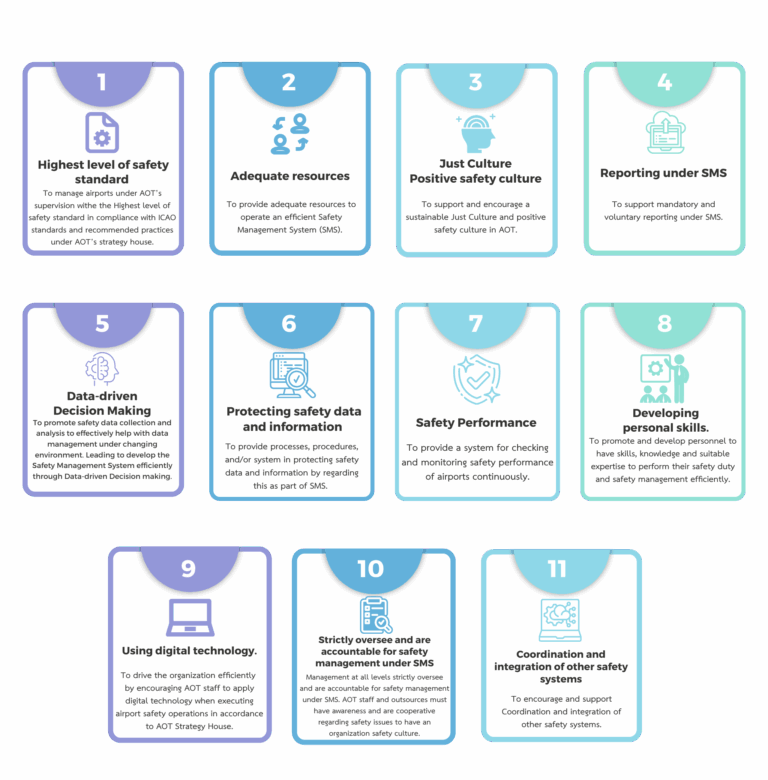
Management Approaches
Establishing Airport Safety Targets
AOT’s Airport Safety Targets
AOT’s primary safety target is to achieve Zero Accidents for airport users and all stakeholders across its six airports during the fiscal years 2023–2027. This target will be pursued through a multi-faceted approach, encompassing policy development, governance structures, operational guidelines, and continuous monitoring.
The AOT Corporate Plan for the Fiscal Years 2023–2027 (Revised Edition for FY 2024) outlines Strategy 1: Expanding Passenger Handling Capacity while Maintaining Airport Safety and Security Standards. Under Tactic 1.2, AOT aims to ensure the effective utilization of airport infrastructure and facilities by enhancing operational efficiency, ultimately achieving the goal of Zero Runway Accidents.
Integration of Safety with External Agencies
AOT, in collaboration with the Civil Aviation Authority of Thailand (CAAT) and other relevant agencies, has incorporated Specific Operation Objectives (OPR) related to airport operations into its operational framework, safety targets, and objectives to drive the Aviation Safety Plan and the Thailand Aviation Safety Action Plan (TASAP).
For the six state-specific objectives, AOT has adopted four objectives related to airport operations as its specific safety targets, which are:
- Reduce the occurrence rate of safety incidents related to Controlled Flight into Terrain (CFIT) resulting from AOT’s Airport Operations.
- Reduce the occurrence rate and severity of Runway Excursions (RE) resulting from AOT’s airport operations.
- Reduce the occurrence rate and severity of Runway Incursions (RI) resulting from AOT’s airport operations.
- Reduce the occurrence rate of bird strikes at AOT airports that cause damage to aircraft through enhanced airport safety operations.
In addition, AOT has established the AOT Aviation Safety Plan Committee with the authority to develop the AOT Safety Action Plan in alignment with TASAP and to set guidelines for the AOT Runway Safety Programme.
Aerodrome Safety Governance and Management Structure
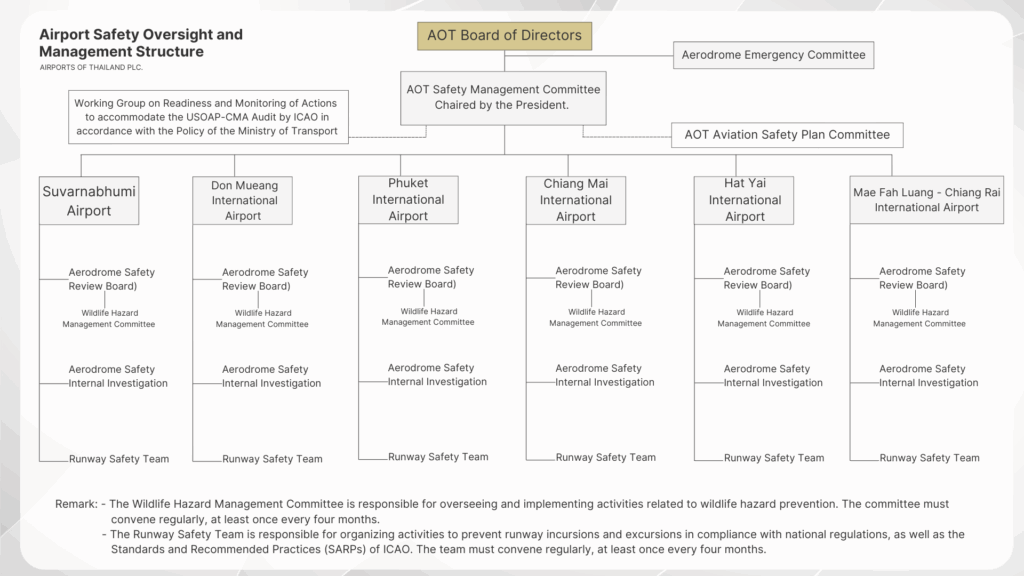
AOT Safety Management Committee
Appointed by the AOT Board of Directors, the President serves as the Chairperson and holds the highest level of responsibility for safety under the organization’s Safety Management System (SMS). The Director of Airport Standards and Safety assumes the role of AOT Safety Manager at the corporate level and concurrently serves as the committee secretary.
Roles and Responsibilities:
- Develop action plans, operational procedures, and define the Acceptable Level of Safety Performance (ALoSPs) in alignment with the National Aviation Safety Plan. Furthermore, the committee is responsible for overseeing, regulating, and evaluating safety performance to ensure compliance with AOT’s established policies, action plans, and ALoSPs. This includes ensuring adherence to AOT regulations, national laws, and international standards.
- Provide recommendations and resolve operational issues that impact airport safety.
- Monitor and expedite corrective actions for airport deficiencies to obtain and maintain the Public Aerodrome Operating Certificate.
- Conduct regular meetings at least every three months or as deemed necessary by the President.
- Support and promote the continuous development of the airport safety management system.
- Report significant AOT safety performance outcomes or safety-related issues affecting AOT airport operations to the AOT Board of Directors.
- Appoint committees, subcommittees, and working groups as appropriate to support operations.
Aerodrome Safety Review Board
The Aerodrome Safety Review Board is appointed by the General Manager of Airport. The Vice President, Airport Standards and Occupational Health Department serves as the Aerodrome Safety Manager and acts as the secretary for the respective airport.
Roles and Responsibilities:
- Develop airport safety policies, plans, and programs to align with AOT’s safety policy.
- Continuously implement safety activities and undertake additional initiatives to enhance airport safety levels in accordance with the recommendations of the Aerodrome Safety Review Board
- Resolve safety-related issues affecting airport operations. If the issue falls beyond the authority of the Aerodrome Safety Review Board, refer it to the AOT Safety Management Committee for consideration.
- Conduct regular meetings at least every three months.
- Monitor and evaluate performance by conducting monthly aviation safety inspections and present the findings to the Aerodrome Safety Review Board and the AOT Safety Management Committee, respectively.
- Appoint subcommittees and working groups as appropriate to support operations.
AOT Aviation Safety Plan Committee
Roles and Responsibilities:
- Develop the AOT Safety Action Plan to support the Thailand Aviation Safety Action Plan (TASAP), ensuring compliance with AOT regulations, legal requirements, and ICAO standards. Additionally, improve and review the AOT Runway Safety Programme to align with government policies and ensure that the Runway Safety Programme at each airport remains consistent with AOT’s Runway Safety Programme.
- Support the operations of the Local Runway Safety Team (LRST) and ensure its integration with the Airport Safety Management System.
- Recommend guidelines and best practices to the Local Runway Safety Team (LRST) and other relevant agencies to promote and enhance the effectiveness of runway safety operations.
- Promote safety awareness campaigns and facilitate the exchange of information and good practices within AOT to prevent runway safety incidents.
- Promote the recording, storage, and collection of operational data in the database system in accordance with the Safety Action Plan. Establish guidelines to enhance the overall safety performance of AOT airports using safety data and information.
- Establish guidelines and promote the utilization of safety data from AOT’s safety database to evaluate, analyze, and monitor precursor events and contributing factors that fall short of the Safety Performance Targets (SPTs) specified in the AOT Safety Action Plan.
- Monitor the implementation of the AOT Safety Action Plan and report progress to the AOT Safety Management Committee at regular intervals or as deemed appropriate during its meetings.
- The Aerodrome Standards and Safety Department serves as the working group and secretary, responsible for organizing meetings in accordance with the operational plan. Additionally, it monitors the implementation of the Runway Safety Programme at AOT-managed airports and reports progress to the AOT Safety Management Committee on a periodic basis.
For the AOT Corporate Plan for the Fiscal Years 2023–2027 (Revised Edition for Fiscal Year 2024), performance indicators have been established under Strategy 1: Expanding passenger handling capacity while maintaining airport safety and security standards. Under Tactic 1.2: Enhancing the effective utilization of airport infrastructure, the plan sets a target of achieving zero runway accidents between 2023 and 2027.
Safety Management System
Safety and Security Management System
AOT’s core operational framework is applied comprehensively across all six airports, with a strong emphasis on establishing a robust Safety and Security Management System in accordance with International Civil Aviation Organization (ICAO) standards. This includes the allocation of adequate personnel, materials, and equipment to ensure safe operations while mitigating potential risks associated with airport activities.
By integrating safety and security measures, AOT aims to deliver a seamless and valuable airport experience for all stakeholders. The Airport Safety and Security Management System consists of the following key components:
- Establish guidelines for the Safety Management System (SMS) and conduct Safety Risk Management (SRM) assessments.
- Establish stringent safety and security measures with strict enforcement.
- Conduct a Safety Management Review.
- Mandate security audits under the Universal Security Audit Program (USAP).
Promote a safety and security culture and enhance the safety skills of AOT employees.
Safety Management System – SMS
AOT operates in compliance with state laws under the supervision of the Civil Aviation Authority of Thailand (CAAT). The establishment of AOT regulations on the Airport Safety Management System (SMS) ensures alignment with national laws and the State Safety Programme (SSP). This system serves as a key mechanism for enhancing aviation safety and consists of four main components:
- Safety Policy and Safety Objectives
- Safety Risk Management (SRM)
- Safety Assurance
- Safety Promotion
As an airport operator, AOT’s safety management efforts extend beyond its internal operations to ensure that all airport services adhere to safety standards. Achieving this requires cooperation from key airport stakeholders, including customers, airlines, ground service providers, aviation support agencies, and government authorities, to effectively implement Safety Risk Management (SRM).
The Safety and Security Risk Identification and Assessment process enables AOT to identify, evaluate, and mitigate risks through incident response plans and preventive measures, thereby minimizing the likelihood and severity of safety-related risks.
Security risk assessment manual and guidelines according to the level of threats to civil aviation of AOT.
AOT has prepared a Security Risk Assessment Manual and Guidelines for Civil Aviation Threat Levels, which aligns with the Civil Aviation Security Risk Assessment Manual of Thailand prepared by the Civil Aviation Authority of Thailand. The objective is to provide airports under AOT’s responsibility with guidelines for identifying threats and assessing security risks at the airport level. It also serves as a guideline for determining measures to mitigate risks and reduce impacts in accordance with the threat levels of each airport, as recommended by the Civil Aviation Authority of Thailand. AOT continuously reviews and updates the manual to ensure it is current and relevant to the situation and threats to civil aviation.
Safety and Security Measures
Security risk assessment manual and guidelines according to the level of threats to civil aviation of AOT.
AOT has prepared a Security Risk Assessment Manual and Guidelines for Civil Aviation Threat Levels, which aligns with the Civil Aviation Security Risk Assessment Manual of Thailand prepared by the Civil Aviation Authority of Thailand. The objective is to provide airports under AOT’s responsibility with guidelines for identifying threats and assessing security risks at the airport level. It also serves as a guideline for determining measures to mitigate risks and reduce impacts in accordance with the threat levels of each airport, as recommended by the Civil Aviation Authority of Thailand. AOT continuously reviews and updates the manual to ensure it is current and relevant to the situation and threats to civil aviation.
Airport Security Plan: ASP
All of AOT 6 airports have prepared their airport security programme (ASP) in compliance with the National Civil Aviation Security Programme (NCASP), issued by the Civil Aviation Authority of Thailand, and the standards of the International Civil Aviation Organization (ICAO) as guidelines and framework for security operation at each airport. Security measures stipulated in the Airport Security Programme of each airport are preventive and proactive plans, which would be reviewed and adjusted continuously to stay up to date.
Airport Security Plan: ASP
All of AOT 6 airports have prepared their Airport Contingency Plans (ACP) to determine relevant units, scope of responsibilities and procedures, as well as coordination methods among airport operators, air navigators, air traffic controllers, local law enforcers, the Civil Aviation Authority of Thailand and other relevant parties that are responsible to respond to acts of unlawful interference to civil aviation. This is to adhere to requirements in the National Civil Aviation Security Programme (NCASP), relevant standards, rules and regulations in order to ensure an effective response to unlawful interference actions.
Information Systems Development on Airport Security (e-Security)
AOT has developed an airport security information system (e-Security) to collect personal history, preventive security operations, issuance of personal security pass, collection of security statistics, quality control of security audits, and security training course. It is conducted with strict and secure operation procedures that help optimize work efficiency of AOT employees and maintain highest security for service users, workers, and other related individuals at the airport.
The system has been further developed and solved the work process problem of the existing system, as well as improved to be up to date. Users can easily save data via Web Application or Native Mobile Application. Also, the system will update the personal data and offenders’ records, as well as the background of persons and vehicles entering the airport areas.
E-Security system supports both centralized use with accessing to all airports’ data and separate use for each airport, and have authentication system where an individual user has his/her own User name and password to access the system according to his/her rights. These would be able to thoroughly monitor the operation procedures of those involved in the system and external incidents. It makes AOT’s airports safer and builds more confidence in passengers or airlines
Currently, AOT has adopted advanced and efficient information and communication technologies to enhance passenger convenience. The Automated Biometric Identification System (Biometric) utilizes facial recognition technology to verify passengers’ identities from check-in to boarding, streamlining services across AOT’s six airports and significantly reducing queuing times.
The system will be launched for domestic passengers on 1 November 2024 and for international passengers on 1 December 2024.
Additionally, the Access Control System (ACS) has been implemented to efficiently screen and monitor individuals, ensuring the highest level of security for passengers and airport operators.
Runway Safety Programme
The Runway Safety Programme for AOT and its airports is designed to compile rules, regulations, standards, and related activities with the goal of enhancing runway safety and improving operational efficiency. This is achieved through data-driven analysis, enabling informed decision-making on safety measures.
By utilizing occurrence analysis, AOT identifies contributing factors to safety incidents. Additionally, gap analysis and other safety data are applied to assess risks, establish preventive measures, and implement systematic monitoring to ensure continuous runway safety improvements.
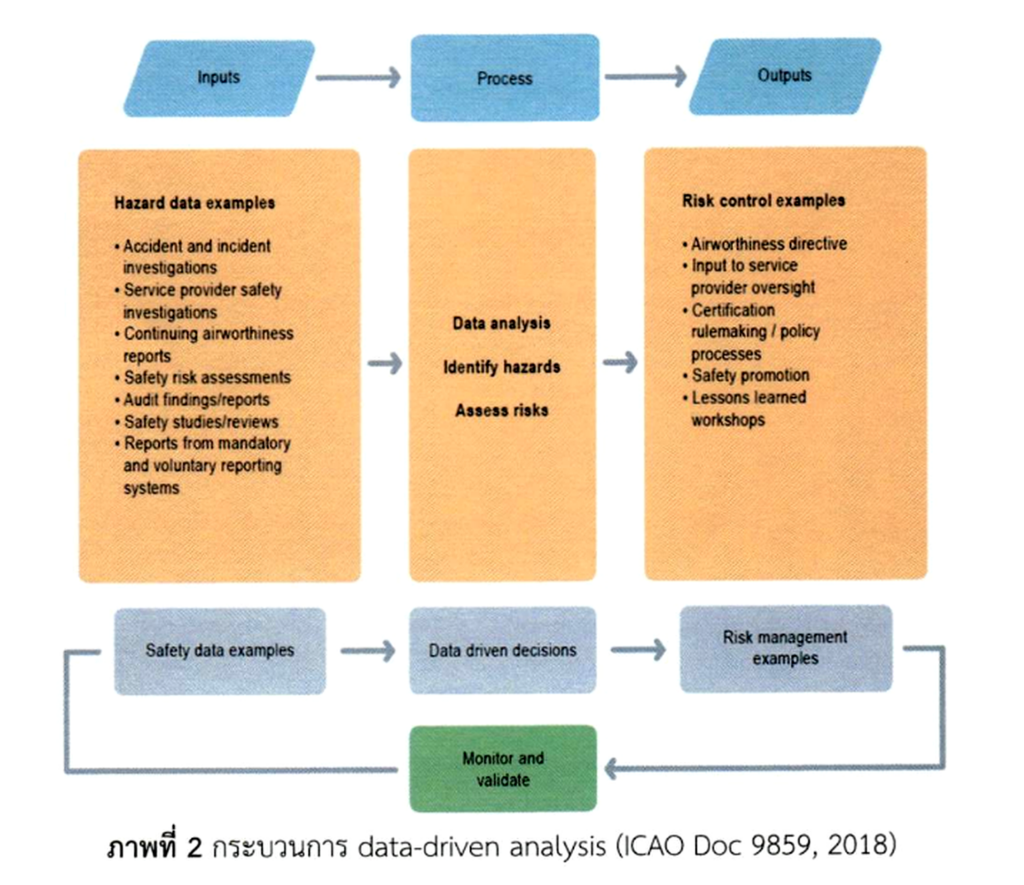
Occurrence Analysis
Occurrence analysis is a process based on hazard identification and risk assessment principles, utilizing data from various sources, such as AOT’s mandatory safety incident reporting, to investigate unsafe incidents and contributing factors related to runway safety. This analysis aligns with the Specific Operational Objectives (OPR) outlined in the Thailand Aviation Safety Action Plan (TASAP) and AOT’s specific safety objectives, which focus on four key incidents:
- Controlled Flight into Terrain (CFIT)
- Runway Excursion (RE)
- Runway Incursion (RI)
- Bird Strikes
Additionally, this process incorporates stakeholder input, including perspectives from government agencies, air traffic service providers, air operators, and airport authorities to ensure a comprehensive approach to runway safety.
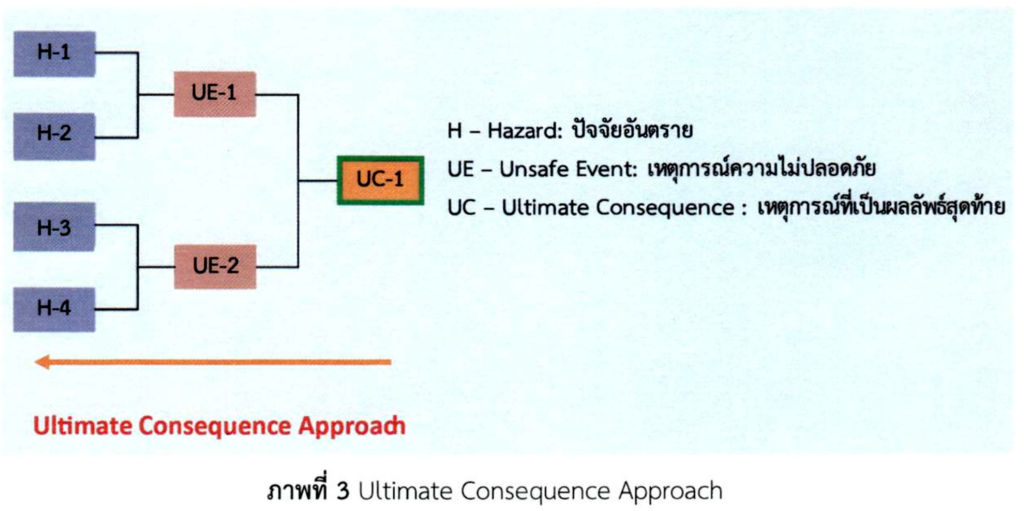
Hazard Identification Method in the Runway Safety Programme
The Runway Safety Programme adopts the Ultimate Consequence Approach as a method for identifying hazard factors and unsafe incidents. This approach begins by analyzing the final outcome, followed by an assessment of unsafe incidents and hazard factors that may contribute to such occurrences. These are then categorized as contributing factors for each incident.
To facilitate the identification of appropriate preventive and mitigation measures, contributing factors are classified based on the ICAO CICTT Aviation Occurrence Categories, ensuring a structured and effective approach to runway safety management.
Management Review
AOT conducts a quarterly review of safety management and security measures, evaluating and updating policies, procedures, and security management processes within airports every three months. These reviews serve as a platform for discussing key management issues and are included as agenda items in safety and security meetings.
Additionally, AOT and the Government implement safety standard audits across both physical and operational aspects as a mechanism to ensure aerodrome safety standards comply with national regulations and international standards, guaranteeing the safety of airport users.
The auditing process is divided into three levels, as follows:
- At the Airport Level (Self-Audit)
The Aerodrome Standards and Occupational Health Division at each airport is responsible for conducting self-audits to assess compliance with airport safety standards.
- At Corporate Level (Internal Audit)
AOT Aerodrome Standards and Safety Department is responsible for internal auditing on safety standards of every airport at least once a year, supervising safety of all airports in general, monitoring risk statistics report, defining level of risk, and searching for reducing/controlling methods to be as Low as Reasonably Practicable (ALARP) level. These implementations will be proceeded through AOT’s Aerodrome Safety Management Committee to ensure that safety deficiencies shall be rectified and safety performance shall be measured according to safety indicators and safety targets as defined by AOT.
- At State Level (State Audit)
The Civil Aviation Authority of Thailand (CAAT), Ministry of Transport, is responsible for auditing and supervising safety standards of airports under AOT’s supervision on an annual basis, as well as providing opinions and suggestions to AOT on safety matters. However, CAAT is also audited and monitored by the International Civil Aviation Organization (ICAO) under the Universal Safety Oversight Audit Program (USOAP).
Aviation Security Quality Control Programme
AOT has prepared the Aviation Security Quality Control Programme to be used as a standard for security quality control at the airports under the responsibility of AOT. The programme involves quality control activities consisting of Security Audit, Security Inspection, Security Test, and Security Survey based on inspection principles and guidelines of the National Civil Aviation Security Quality Control Programme (NCASQCP). In addition, AOT’s Internal Auditors were trained in courses according to international standards.
Safety and Security Culture
AOT recognizes the importance of developing and enhancing the knowledge and skills of its personnel to strengthen a modern management system. This is achieved by offering both theoretical and practical safety training courses, conducting airport emergency drills, and consistently fostering a safety and security culture within the organization. The details are as follows:
- Creating awareness and understanding of safety and security procedures, including operational frameworks and manuals, for continuous development and improvement.
- Raising awareness among personnel to prevent and mitigate potential risks related to airport safety, including reporting any risks or incidents that may arise and cause various impacts.
- Developing e-Safety and e-Security information systems for airports to integrate with safety and security operations and management.
- Utilizing data collected through digital technology for analysis and management to enhance AOT’s safety and security management efficiently.
- Gathering feedback through various AOT channels and applying lessons learned from incidents to develop and improve operational practices.
Performance
In line with the goal of achieving zero accidents for passengers and all stakeholders across all six airports, AOT’s performance in 2024 has resulted in below table.
| Key Performance Indicators (KPIs) | Performance in 2024 | Target for 2024 |
|---|---|---|
| Rate and severity of Runway Excursion (RE) incidents | 3 | 0 |
| Rate and severity of Runway Incursion (RI) incidents | 7 | 0 |
| Rate of Bird Strike incidents causing aircraft damage | 24 | 0 |
| Number of runway accidents (Zero Accident target) (cases) | 0 | 0 |
Promoting a Culture of Safety and Security
AOT has a safety operations structure in collaboration with external agencies, such as organizational and airport level safety committees consisting of representatives from various departments both inside and outside the airport. By holding a meeting to discuss according to the specified circle. to exchange information, identify risks Evaluate and create measures to reduce risks that cause mutual insecurity. Including promoting shared safety by conveying and communicating to create a safety culture. In the fiscal year 2024, AOT organized a Safety Campaign in the airside area of Don Mueang International Airport (DMK). The campaign was attended by airport executives, relevant departments of DMK, representatives from the Medical Department, airline representatives, and airside operators.
Held from January to April 2024, the campaign featured several key activities, including:
- Big Cleaning Day
- Airside Unsafe Conditions Reporting
- Safety Awareness Training for Airside Personnel
- Foreign Object Debris (FOD) Collection Campaign
- Safe Driving in the Airside Area Campaign
The campaign aimed to enhance safety knowledge, awareness, and understanding among airside personnel, ensuring that safety performance indicators remain within acceptable limits. Additionally, it sought to minimize risks to life and property, thereby preserving the reputation of both the organization and the country.
Emergency and Contingency Plan Drills
All airports under AOT’s responsibility have established Airport Contingency Plans in accordance with government regulations and aligned with the standards of the International Civil Aviation Organization (ICAO). Regular drills are conducted as per the scheduled intervals. During each drill, current threat information is considered to create realistic scenarios, selecting high-risk threats for practice. This ensures the ability to effectively respond, control, direct, and restore normal operations quickly, maintaining business continuity.
